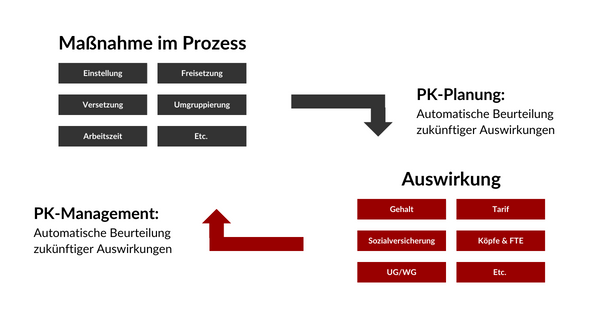Steps to successful corporate management
Let’s be clear: personnel actions are the only thing we can do in HR to align staffing and personnel costs with the needs of the organization:
- Setting
- Release
- Promotion
- Transfer
- Change in working hours
- Fee adjustment
- Etc.
These measures generally have an impact on staffing (FTE, headcount) and costs, either for the entire organization or, in the case of transfers, for parts of it.
From this perspective, it is unmistakable that personnel measures must be the focus of HR controlling. Personnel costs and staffing do not arise on cost centers and accounts, they cannot be changed at will – they are the result of personnel actions carried out for employees and, by extension, for positions.
Step 1: Personnel cost planning
Accordingly, planning must be based on measures. Only then is it feasible in reality and only then is it reliable, because the rules that apply to the individual measures determine their effects.
A plan that cannot be implemented in reality is useless.
If personnel cost planning is based on measures, it is the task of the personnel cost planning system to evaluate the effects of the measures. The “input” is personnel measures, the “output” their effects.
Users must be able to plan personnel measures as simply and productively as possible and be confident that their effects are calculated correctly and are immediately visible – as a rule, personnel cost planning is carried out with a fixed target, e.g. a specified total increase, in mind.
The personnel cost planning system must correctly evaluate the measures, taking into account the rules applicable to the measures.
Technically, a distinction is also made between the measures and the effects (results) – both pieces of information are stored separately. So the system “knows” what should be done and what the effects will be.
Step 2: Personnel cost management
Personnel cost management includes:
- Projections for the current fiscal year
- Evaluations and analyses (target/actual comparisons, etc. pp.)
- Simulations
It is necessary to generate reliable projections. This makes it possible to see at an early stage how the current year will close compared with the plan for the current year. Time is bought to react as soon as a mismatch appears in the projection. Without a good projection, the disproportion is not recognized until it has occurred, which is usually too late.
The projection consists of the actual results (i.e., the settlement results of settled months), the measures contained therein, and the future results, which are determined both by the measures already implemented in the actual and by future measures.
This automatically provides a very reliable projection based on the assumption that the future measures will be implemented unchanged. Adjustments to the projection are easily made by adjusting the measures that lie in the future.
Once reliable projections have been generated in this way, they can be used for evaluations and analyses, react to changes in the underlying conditions (such as negative business development) and generate robust simulations.
It is important to keep in mind that evaluations and analyses can show which measures that were not/other/additionally implemented led to deviations. It is thus possible for the first time to explain deviations from an HR perspective instead of just pointing them out.
Fazit
Personnel measures are the core of HR controlling. For planning staffing and personnel costs, their impact is evaluated. The plan thus consists of actions (“what will we do”) and impacts (“what will follow from this in terms of staffing and costs”).

In Personnel Cost Management, actual values are examined for the measures they contain and processed together with future measures in the projection. In analyses, results and measures are available in actual and planned form, which enables completely new statements on the causes of deviations.
Adjustments to the projection, for example in the event of changes in general conditions, are made in the same way as in planning via future measures.




